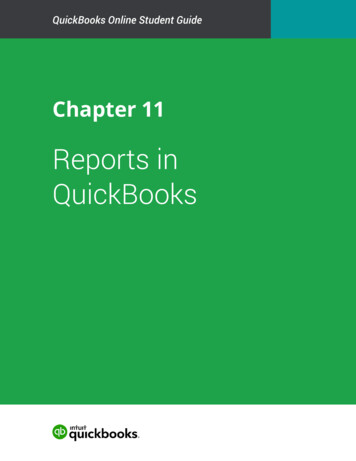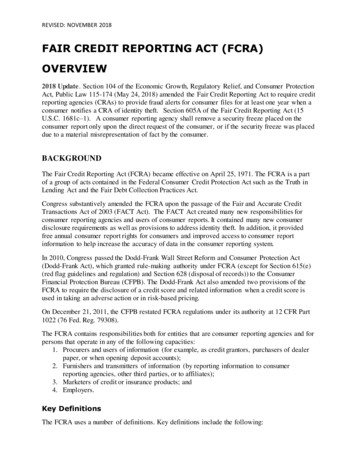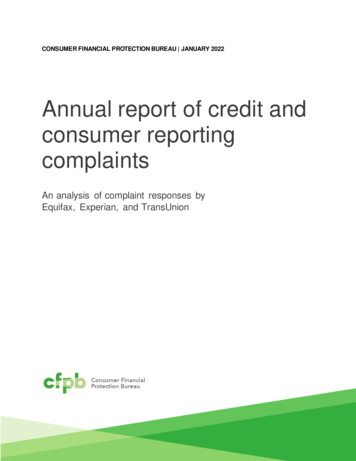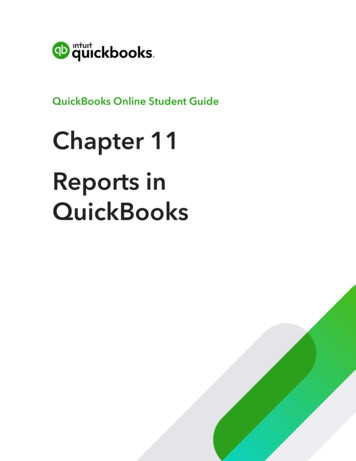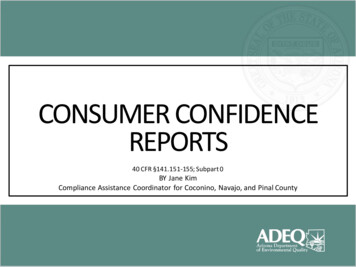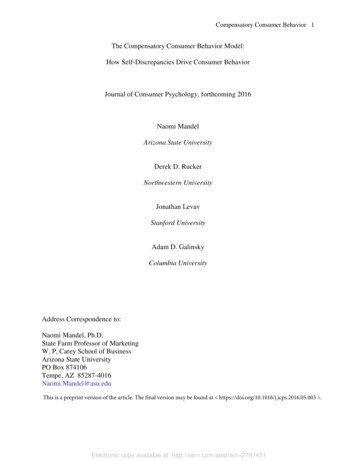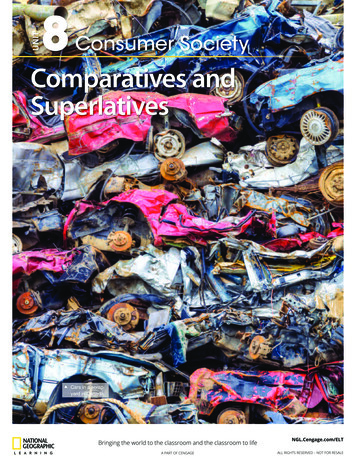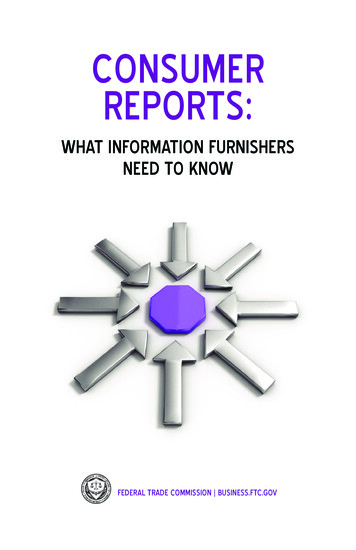
Transcription
CONSUMERREPORTS:WHAT INFORMATION FURNISHERSNEED TO KNOWFederal Trade Commission business.ftc.gov
The Fair Credit Reporting Act (FCRA) is designed to protectthe privacy of consumer report information — sometimesinformally called “credit reports” — and to guarantee thatinformation supplied by consumer reporting agencies (CRAs)is as accurate as possible.If you report information about consumers to a CRA — like acredit bureau, tenant screening company, check verificationservice, or a medical information service — you havelegal obligations under the FCRA’s Furnisher Rule. Yourresponsibilities include: furnishing information that is accurate and complete,and investigating consumer disputes about the accuracy ofinformation you provide.The Federal Trade Commission, the Consumer FinancialProtection Bureau, and the federal banking agencies haveeach published a Furnisher Rule. The rules are identical insubstance. The FTC’s Rule is summarized here. If you are notsubject to the FTC’s jurisdiction, contact your regulator aboutyour obligations.AccuracyWhen you provide information to a CRA, you have obligationsunder the FCRA to ensure the accuracy of the informationyou furnish. As a rule, it’s illegal to report information thatyou know or believe is inaccurate. You have “reasonablecause to believe” that information is inaccurate if you haveknowledge, other than allegations from the consumer, thatwould lead a reasonable person to doubt the accuracy of theinformation. FCRA Section 623(a)(1)(A) You may be exemptfrom this requirement if you give an address for consumers1
to report inaccurate information, but you cannot, under anycircumstances, report information the consumer has told youis inaccurate if it is, in fact, inaccurate.FCRA Section 623(a)(1)(C)Guidelines for Policies and ProceduresYou must establish and implement written policiesand procedures regarding the accuracy and integrityof information you furnish to a CRA. Guidelines are inAppendix A to Furnisher Rule Part 660. Read the Appendix;the information here is just a sample.Your policies and procedures:2 must be appropriate to the nature, size, complexity, andscope of your activities; must be reviewed periodically and updated, asnecessary; should ensure that information provided to a CRA is forthe right person, and reflects the terms of the accountand the consumer’s performance on the account; require maintenance of records for a reasonable amountof time; establish internal controls for the accuracy and integrityof information, such as through random sampling; prevent re-aging (inaccurately changing the date of firstdelinquency on a consumer’s account to a later date)and duplicative reporting, particularly following portfolioacquisitions or sales, mergers, and other transfers; and require updating of furnished information wherenecessary.
Information should: be substantiated by your records when it is furnished; include consumer identifiers, like name(s), date ofbirth, Social Security number, telephone number(s), oraddress(es); and be furnished in a standardized form and specify the timeperiod it pertains to.Correct and Update InformationIf you furnish information to a CRA on a regular basis anddetermine that any information you provided is inaccurate orincomplete, you must promptly notify the CRA and providecorrections or additions. Going forward, you must furnish onlythe correct information to the CRA. FCRA 623(a)(2)(B)Furnishing Specific ItemsThe FCRA requires that if you furnish any information to aCRA, you must include any of the following items that areapplicable to you.Credit Limits — Usually, you must include a consumer’s creditlimit among the information you furnish to a CRA. Appendix A(I)Disputed Information — Once a consumer disputesinformation, you may not report that information to a CRAwithout telling the CRA that the information is in dispute.FCRA 623(a)(3)Closed Accounts — If you furnish information to a CRA ona regular basis, you must notify the CRA that a consumerhas voluntarily closed an account the next time you sendinformation that would normally include that account. This isimportant because some users of information may interpret3
a closed account as an indicator of bad credit unless youclearly disclose that the consumer, not the creditor, closedthe account. FCRA 623(a)(4)Delinquent Accounts — When you refer an account forcollection and notify a CRA that you have done so, youalso must report the date of delinquency to the CRA within90 days. The date of delinquency is the month and yearthe consumer’s delinquency resulting in the referral began.See the examples below. FCRA 623(a)(5)(A)If you are a debt collector furnishing information to a CRAabout the accounts of a creditor, you must report the date ofdelinquency given to you by the creditor. FCRA 623(a)(5)(A)This “date of delinquency” determines how long the debt canbe reported on a consumer’s credit report. Generally, a CRAmay report a delinquent debt for seven years from the dateof delinquency. If the debt was discharged in bankruptcy,however, a CRA may report it for 10 years.If the creditor didn’t report the date of delinquency, you havetwo options:41.You may establish and follow reasonable proceduresto determine the date from the original creditor oranother reliable source, or2.If you can’t determine the date, you may establishand follow reasonable procedures to ensure that thereported date of delinquency is a date before theaccount was referred to collection or charged off.FCRA 623(a)(5)(B)
These examples illustrate how to calculate the date ofdelinquency:John Smith’s account becomes delinquent in March 2017. Thecreditor places the account for collection on October 1, 2017.In this case, the date of delinquency is March 2017. The datethat the creditor places the account for collection is not thebasis for calculating the delinquency date. The collection dateis calculated based on the consumer’s delinquency, not thecreditor’s later actions.Mary Myers’s credit card account becomes delinquent inApril 2016. Mary makes partial payments for the next fivemonths, but never brings the account current. The creditorplaces the account for collection in January 2017.Because the account was never brought current during theperiod partial payments were made, the delinquency thatimmediately preceded the collection began in April 2016,when Mary first became delinquent. The correct delinquencydate is April 2016.Alan Clark’s account becomes delinquent in December 2015.The account is placed for collection with Collector A onApril 1, 2016. Collection is not successful. The creditor placesthe account with Collector B in February 2017.The date of the delinquency for reporting purposes isDecember 2015. Repeatedly placing an account forcollection or using different collectors does not change thedelinquency date.Lisa Long’s account becomes delinquent in November 2017.The creditor has never reported the date of the delinquentaccount to the CRAs, but has records indicating the date ofdelinquency as November 2017. A debt collector acquires thedebt and attempts collection.5
If the debt collector establishes and follows reasonableprocedures to learn the date of delinquency from the creditor— and finds that November 2017 is the delinquency date —the debt collector may report that date to the CRAs as thedelinquency date. FCRA 623(a)(5)(B)(ii)Craig Coleman’s account becomes delinquent, but thecreditor never reports the delinquency date to a CRA. Inaddition, the delinquency date can’t be reasonably obtainedfrom the creditor or another reliable source. The account isplaced for collection in November 2017.If the debt collector establishes and follows reasonableprocedures to ensure that the delinquency date reportedprecedes the date the account is placed for collection,charged to profit or loss, or subjected to any similar actionby the original creditor, the debt collector may report thatalternate delinquency date to a CRA. In this case, thealternate delinquency date must be before November 2017.This method should be used only when the original date ofdelinquency can’t be determined from the creditor or anothersource. FCRA 623(a)(5)(B)(iii)Negative Information from Financial Institutions — If you area financial institution (as defined in the Gramm-Leach-BlileyAct) that extends credit and regularly reports negativeinformation about your customers to a nationwide CRA (forexample, Equifax, Experian, or TransUnion), you must notifyyour customers that you report such negative information.Examples of negative information include a customer’sdelinquencies, late payments, insolvency, or any form ofdefault. FCRA 623(a)(7)(G)(i)6
You must provide the notice either before you furnish thenegative information or within 30 days of furnishing it. Youmay include the notice with a notice of default, a billingstatement, or another item sent to the consumer, but youcannot send it with a Truth In Lending Act notification. Thenotices must be clear and conspicuous.The Consumer Financial Protection Bureau has modeldisclosures at 12 CFR Part 1022, Appendix B, FCRA 623(a)(7).Medical Information — If your primary business is providingmedical services, products, or devices, and you, your agent,or your assignee reports information about consumers toCRAs, you must notify each CRA that you are a medicalprovider. FCRA 623(a)(9) This notice helps the CRAs complywith their FCRA duties with regard to the reporting of medicalinformation. FCRA 604(g) For example, if the name, address,and telephone number of a medical information furnisherappears on a consumer report, the information must beencoded so it doesn’t identify the specific provider or thenature of the services, products, or devices. FCRA 605(a)(6)(A)The federal banking agencies have issued rules to implementthese requirements.DISPUTESConsumers may dispute information that you furnished intwo ways:1.They may submit a dispute to the CRA.2.They may submit a dispute directly to you.7
Disputes to CRAsIf a CRA notifies you that a consumer disputes informationyou provided, you must: investigate the dispute and review all relevantinformation provided by the CRA about the dispute; report your findings to the CRA; provide corrected information to every CRA thatreceived the information if your investigation shows theinformation is incomplete or inaccurate; and modify the information, delete it, or permanently blockits reporting if the information turns out to be inaccurateor incomplete or can’t be verified. FCRA 623(b)(1)You must complete these steps within the same timeallowed under the FCRA for the CRA to resolve the dispute.Normally, this is 30 days after the CRA gets the disputefrom the consumer. If the consumer provides additionalrelevant information during the 30-day period, the CRA has15 more days to resolve the dispute. The CRA must giveyou all the relevant information it gets within five businessdays of receipt, and must promptly give you additionalrelevant information provided by the consumer. If you don’tinvestigate and respond to the notification of the disputewithin the specified times, the CRA must delete the disputedinformation from its files. FCRA 623(b)(2) and 611(a)(1)Disputes to FurnishersYou must investigate a consumer’s dispute if it relates to: 8the consumer’s liability for a credit account or otherdebt with you. For example, disputes relating to whetherthere is or has been identity theft or fraud against the
consumer, whether there is individual or joint liability onan account, or whether the consumer is an authorizeduser of a credit account; the terms of a credit account or other debt with you.For example, disputes relating to the type of account,principal balance, scheduled payment amount on anaccount, or the amount of the credit limit on an openend account; the consumer’s performance or other conductconcerning an account or other relationship with you.For example, disputes relating to the current paymentstatus, high balance, date a payment was made,amount of a payment made, or date an account wasopened or closed; or any other information in a consumer report aboutan account or relationship with you that affects theconsumer’s creditworthiness, credit standing, creditcapacity, character, general reputation, personalcharacteristics, or lifestyle. Furnisher Rule 660.4(a)You must: conduct a reasonable investigation review all relevant information provided by the consumer report results to the consumer, generally within 30 days notify each CRA to which you provided inaccurateinformation if the investigation finds the information wasinaccurate. Furnisher Rule 660.4(e)You are not required to investigate the dispute if it relates to: the consumer’s identifying information on a consumerreport, including name, date of birth, Social Securitynumber, phone number, or address;9
the names of previous or current employers; inquiries or requests for consumer reports; information from public records, including judgments,bankruptcies, and liens; information related to fraud alerts or active duty alerts; information provided to a CRA by another furnisher; or when you believe that the dispute is submitted by,prepared on behalf of the consumer by, or submittedon a form supplied to the consumer by a credit repairorganization. Furnisher Rule 660.4(b)You also are not required to investigate disputes that arefrivolous or irrelevant, as defined by the Rule: the consumer didn’t provide enough information the dispute is substantially the same as a disputepreviously submitted you already fulfilled your obligation, and there is no newinformation you are not required to investigate the dispute, asdescribed in the list above from 660.4(b).Furnisher Rule 660.4(f)If a dispute is found to be frivolous or irrelevant, you mustnotify the consumer within five business days of receivingthe dispute. This notice can be a form letter. Include thereason for the determination and, if relevant, any informationthe consumer needs to submit so you can investigate thedisputed information.10
ADDITIONAL RESPONSIBILITIESVictims of Identity TheftWhen you are notified by a CRA that a consumer’s identityhas been stolen, you have specific duties under the FCRA.FCRA 605B If a CRA notifies you that information you furnished isbeing blocked on a consumer’s credit report because ofidentity theft, you must have procedures to prevent there-reporting of the information. FCRA 623(a)(6)(A) If a CRA notifies you that a debt has resulted fromidentity theft, you may not sell, transfer, or place thatdebt for collection. FCRA 615(f)(1) If a consumer notifies you that he is a victim of identitytheft, and gives you an identity theft report, you may notfurnish information to a CRA regarding the fraudulentaccount or debt. FCRA 623(a)(6)(B) If you find that you furnished inaccurate information dueto identity theft, you must promptly notify each CRA ofthe correct information. Going forward, you must reportonly complete and accurate information. FCRA 623(a)(2) If you provide credit, goods, or services to consumers,you may be required to supply application or othertransaction records to an identity theft victim or lawenforcement officer, if they ask. FCRA 605B(f) 615(g) If you establish or extend credit plans or accounts,you may be required to follow certain steps to verify aconsumer’s identity when you see a fraud or active dutyalert on his credit report. FCRA 605A(h)(B)(ii)11
Disposing of Consumer Report InformationWhen you are finished using a consumer report, you mustsecurely dispose of the report and any information yougathered from it. That can include burning, pulverizing, orshredding paper documents, and disposing of electronicinformation so that it can’t be read or reconstructed. For moreinformation, see Disposing of Consumer Report Information?Rule Tells How at business.ftc.gov.Address DiscrepanciesIf you are a user of consumer reports and a CRA notifiesyou that the consumer address you provided is substantiallydifferent from the address it has, you must have policies andprocedures to investigate and furnish the consumer’s correctaddress to the CRA. For more information, see Duties ofUsers Regarding Address Discrepancies.NON-COMPLIANCEIf you don’t comply with the FCRA, you may be sued by theFTC, Consumer Financial Protection Bureau (CFPB), stategovernments, or in some cases, consumers. The FCRAprovides for maximum penalties of 4,063 per violation in thecase of lawsuits brought by the FTC. FCRA 616, 617, 621Your Opportunity to CommentThe National Small Business Ombudsman and 10 RegionalFairness Boards collect comments from small businessesabout federal compliance and enforcement activities.Each year, the Ombudsman evaluates the conduct ofthese activities and rates each agency’s responsivenessto small businesses. Small businesses can comment to12
the Ombudsman without fear of reprisal. To comment, calltoll-free 1-888-REGFAIR (1-888-734-3247) or go tosba.gov/ombudsman.The FTC works for the consumer to preventfraudulent, deceptive, and unfair business practicesin the marketplace and to provide information to helpconsumers spot, stop, and avoid them. To file a complaintor to get free information on consumer issues, visitconsumer.ftc.gov or call toll-free, 1-877-FTC-HELP(1-877-382-4357); TTY: 1-866-653-4261. The FTC entersconsumer complaints into the Consumer Sentinel Network,a secure online database and investigative tool used byhundreds of civil and criminal law enforcement agencies inthe U.S. and abroad.[Note: Edited January 2020 to reflect Inflation-Adjusted Civil Penalty Maximums.]13
Federal Trade CommissionBCP Business Centerbusiness.ftc.govNovember 2016
The Consumer Financial Protection Bureau has model . disclosures at 12 CFR Part 1022, Appendix B, FCRA 623(a)(7). Medical Information — If your primary business is providing . medical services, products, or devices, and you, your agent, or your assignee reports information about consumers
